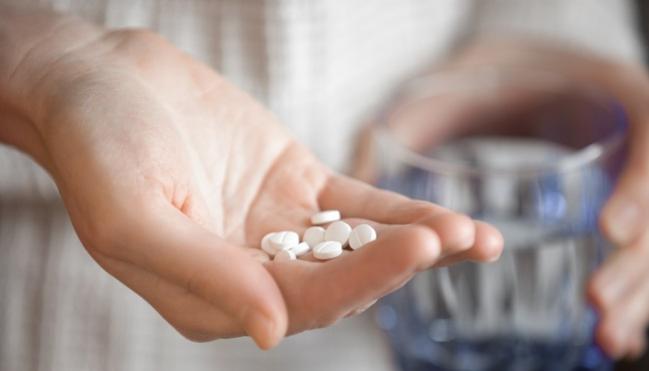Cilostazol-Based DAPT Safe, Effective in Patients at High Risk for Recurrent Stroke
The CSPS.com trial has limitations but raises questions about whether more patients will benefit from dual antiplatelet therapy.

HONOLULU, HI—Using cilostazol in combination with either aspirin or clopidogrel safely reduces recurrent strokes in high-risk patients, the CSPS.com trial out of Japan shows.
Through a median follow-up of 17 months, the rate of recurrent ischemic stroke was 4.7% in patients receiving combination therapy and 11.4% in those receiving either aspirin or clopidogrel alone (HR 0.49; 95% CI 0.31-0.76), with consistent findings across subgroups, according to Kazunori Toyoda, MD (National Cerebral and Cardiovascular Center, Suita, Japan).
GUSTO severe or life-threatening bleeding events—all intracranial hemorrhage in this trial—occurred in 2.0% with dual antiplatelet therapy (DAPT) and 2.7% with monotherapy (P = 0.35), he reported here at the International Stroke Conference.
“Addition of cilostazol to aspirin or clopidogrel is recommendable for the long-term use in the chronic stage of high-risk noncardioembolic stroke for patients who [can tolerate] early side effects of cilostazol, such as headache and palpitation,” Toyoda said during his presentation.
DAPT With Lower Bleeding Risk
Prior studies have shown that DAPT with aspirin and clopidogrel lowers early risk of recurrence in patients with ischemic stroke but is not suitable for longer-term use because of a lack of efficacy and increased bleeding risk. Cilostazol, a phosphodiesterase 3 inhibitor that is approved for reducing the symptoms of intermittent claudication (but not secondary stroke prevention) in the United States, carries a relatively low risk of serious bleeding, making it perhaps more suitable for long-term use as part of DAPT regimens.

Kazunori Toyoda, MD
The CSPS.com trial, conducted at 292 sites in Japan, was designed to explore that possibility. Investigators enrolled 1,879 patients (well short of the planned 4,000) who had a noncardioembolic ischemic stroke in the past 8 to 180 days, were taking either aspirin 81 to 100 mg or clopidogrel 50 to 75 mg, and had at least one criteria placing them at high risk for recurrent stroke. They were randomized to DAPT with cilostazol 100 mg twice daily plus either aspirin or clopidogrel or to aspirin or clopidogrel alone. Mean patient age was 70, and 30% of participants were women.
For the analyses, the researchers compared all DAPT regimens with all monotherapy regimens, showing a lower risk of recurrent ischemic stroke (primary outcome) with DAPT. Several secondary outcomes—including a composite of stroke, MI, or vascular death (6.2% vs 21.4%; HR 0.52; 95% CI 0.35-0.77)—were reduced as well.
In terms of safety, the rate of overall adverse events was higher in the DAPT arm (27.4% vs 23.1%; P = 0.038). Palpitation/tachycardia and headache were commonly observed in patients receiving cilostazol, and those side effects seemed to be the main reason that about 20% of patients in the DAPT arm stopped trial medications within 6 months, Toyoda said.
In contrast, total serious adverse events were more frequent in the monotherapy arm (15.0% vs 9.3%; P < 0.001). Toyoda noted that efficacy endpoints like stroke were included in this tally.
Overall bleeding events occurred in 4.1% of patients receiving DAPT and 3.5% of those receiving aspirin or clopidogrel alone, a nonsignificant difference.
‘Approach Has Merit’
American Heart Association/American Stroke Association spokesperson Karen Furie, MD (Lifespan, Providence, RI), told TCTMD that interpretation of the results is complicated by the fact that treatment regimens varied within each arm of the trial, with different combinations or doses used, and by the unusually low rates of bleeding observed.
That said, “the approach has merit,” Furie commented, adding that there has been expanded use of DAPT in recent years as a result of data coming out of several trials, including SAMMPRIS, CHANCE, and POINT.
“So the whole field really—after many years of avoiding dual antiplatelet therapy after the MATCH trial failed to show a benefit—has moved toward the use of these different dual regimens,” Furie said.
Still, CSPS.com is not necessarily practice-changing because of the murkiness of the results, she said, adding that detailed information on the exact regimens used in a full publication might clear some of that up.
“I think this trial raises questions about whether there may be other populations that benefit from dual antiplatelet approaches. And I would like to either see additional data from this trial or potentially another trial that helps tease out some of these issues, so that we can implement it actually into something more focused than this trial suggests,” Furie said.
Todd Neale is the Associate News Editor for TCTMD and a Senior Medical Journalist. He got his start in journalism at …
Read Full BioSources
Toyoda K. Dual antiplatelet therapy using cilostazol for high-risk ischemic stroke: the Cilostazol Stroke Prevention Study for Antiplatelet Combination (CSPS.com). Presented at: ISC 2019. February 6, 2019. Honolulu, HI.
Disclosures
- CSPS.com was conducted under a trial contract between the study sponsor, the Japan Cardiovascular Research Foundation, and the supporting company, Otsuka Pharmaceutical Co., Ltd.
- Toyoda reports serving on the speakers' bureau for Bayer Yakuhin, Daiichi Sankyo, Bristol-Myers Squibb, and Nippon Boehringer Ingelheim.


Comments